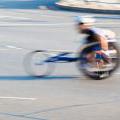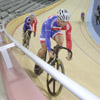-

Usain Bolt, the "fastest man on the planet", aims to get his 100 metre world record of 9.58 seconds down to 9.40 seconds. But is there an ultimate limit which no runner can possibly break? In this article, aimed at the general public and older students, Tony Crilly looks at whether mathematics can give us the answer.
-

The epic Isner-Mahut match at Wimbledon in 2010, where the fifth set lasted for three days, may have sent shivers down the spine of Olympics schedulers. But how freakish an event was it, and what's the probability that a similar situation might arise in 2012? This article, aimed at older students and the general public, investigates.
-

The Olympic and Paralympic Games are a global celebration of excellence, determination and effort. Much of the media coverage, though, tends to focus on each country's tally of gold medals. This article by Rob Eastaway and John Haigh explores some of the mathematical questions raised by Olympic success. How well did Britain really do in 2008 in Beijing, with nineteen golds? Are some gold medals worth more than others? And are there even some sports the Olympics should drop?
-

How can mathematical models help us understand the beautiful game? Playing ball games often involves modifying the ball's flight to gain tactical advantage by hitting or kicking it in a particular way. Ken Bray investigates aerodynamics in football in this article, aimed at older students and the general public.
-

For this article Plus, our free online maths magazine, interviewed leading researchers in sports technology and engineering to learn more about their work with Olympic and Paralympic athletes in a range of sports. Improvements to equipment or clothing may save only a few hundredths of a second, but that can mean the difference between a silver or gold medal.
-

Table tennis first became an Olympic sport in 1988, but changed its scoring system in 2001 to make matches more exciting for spectators. But how does the new system compare to the old one in terms of your chances of winning? This article, aimed at older students and the general public, investigates.
-

This article explores the Velodrome, the first of the London 2012 venues to be completed. With its sweeping curved roof and beautiful cedar clad exterior the Velodrome is a stunning building. But what most of the athletes are excited about is the elegant wooden cycle track enclosed inside. How does its geometry contribute to speed?
-

What's the link between a spectacular gymnastic routine and a rollercoaster? This short article, aimed at older students and the general public, explains.
-

Accuracy matters when it comes to building Olympic sports venues. This short article, aimed at older students and the general public, looks at why small errors can have large consequences for record-breaking sporting performance.
-

In the 2008 Beijing Olympics the UK finished 4th in the total medal count. How might we do in 2012, and does the country hosting the Olympics have an edge?

